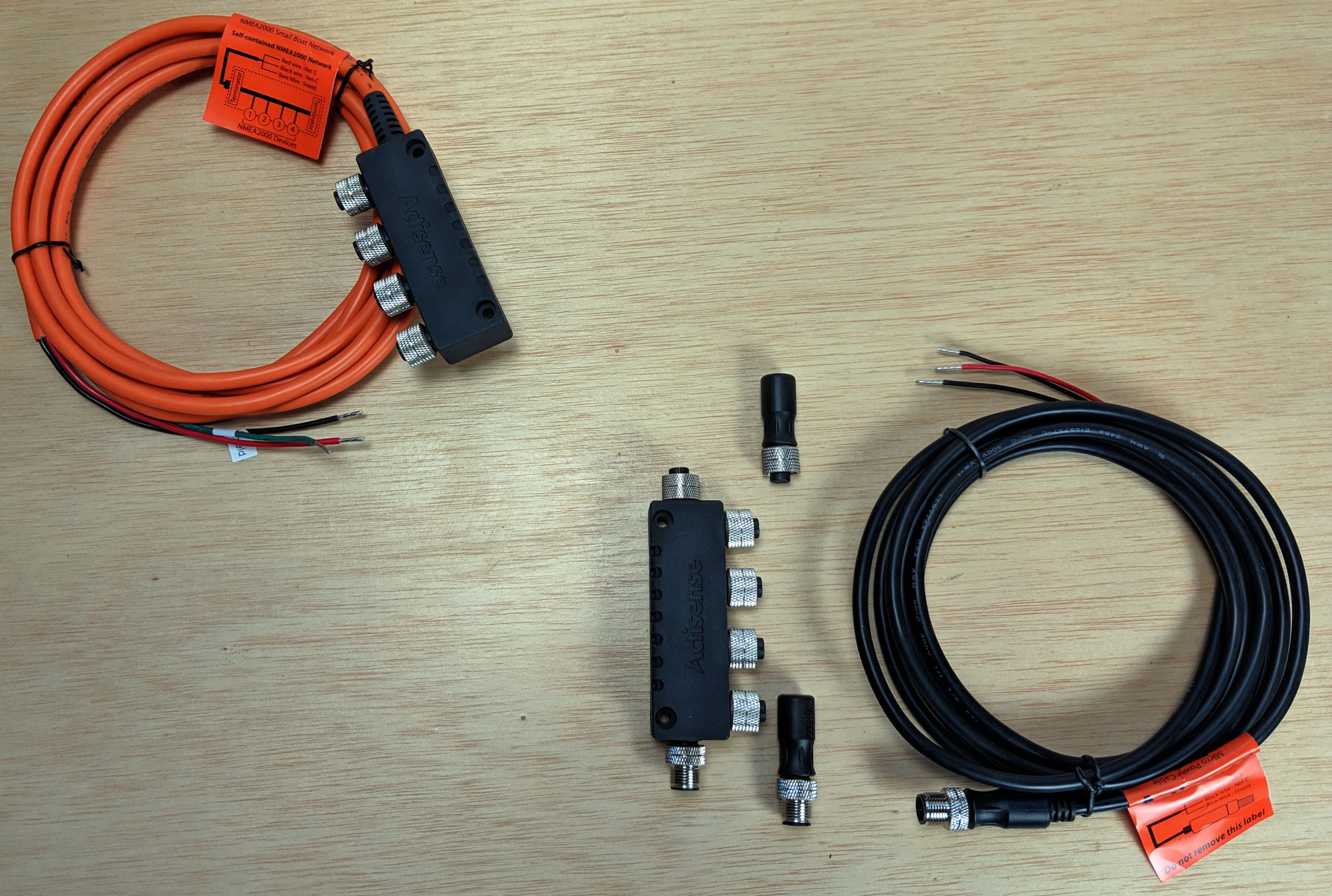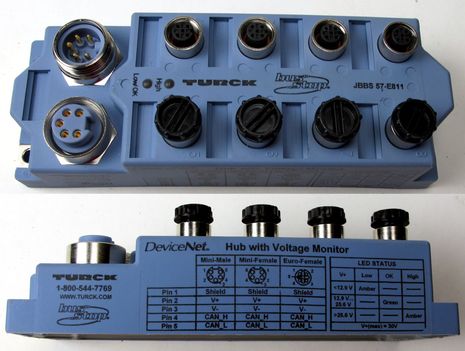Raymarine STng, the pin mystery

I’m on deadline today, and may find no more time for posting, but here’s a puzzle to ponder. Those two male female connectors above are unique to Raymarine’s SeaTalkNG (or STng) version of NMEA 2000 cabling. The white version is on both ends of every “spur” cable that’s used to connect devices to the backbone—or to daisy chain one device to another—and the blue version is on both ends of every backbone segment. So why in tarnation does one have six pins and the other five?
Especially as a normal white-headed spur cable only contains the five standard NMEA 2000 wires! Admittedly it took me a while to get my head around what’s going on, but there are two good reasons for that extra pin. In fact, I now understand some rationals for STng (others are also baffled), which I’ll discuss soon, along with more ST70 fun. But for now, can any of you marine electronics geeks figure out the pin mystery?














Ah, a smart alec answer has already arrived via email:
“…so that you can’t use off-the-shelf N2k hardware with it?”
Which may or may not be a motive, but certainly isn’t one of the “two good reasons” for that extra pin.
The extra pin is for shielding….
Ben,
For shame. Those are FEMALE connectors!!
Thanks, Bill! I changed it, but this is an interesting case of gender confusion. The individual pin sockets are definitely female, but the whole connector fits into, not around, the tee or device connector. The STng manual doesn’t mention gender either way, but Wikipedia suggests that in similar cases—like a “male” VHF coax lead from an antenna—the pin determines gender.
By the way, if you look at standard NMEA 2000 connectors, you’ll see that the males are all male, inside and out 😉
Sorry, Scott, nice try, but that would be a “No”.
Bwwwwannnnkk!! (Judge’s buzzer)
Hmmm… maybe another pin for +V, to allow for center-feed powering of two independent circuits?
While there may be some technical virtue, it’s a very non-technical decision to make it more difficult to connect non-Raymarine equipment to the backbone.
How many times do we have to discuss the benefits of standards? The broad adoption of a standard totally trumps the technical benefit of any variation on the standard, or for that matter a technically superior solution. As always, Beta / VHS is the benchmark example of a mediocre technology trumping a superior technology.
I believe that even Raymarine will eventually see the light and adopt standard connectors. The only question is how many of your readers will be struggling to find adapters from STng to N2K so they can install a non-Raymarine product.
It’s good old SeaTalk data on that pin. Is only used when connected to a ST70.
/Marcus
Ding! Ding! Ding! We have a winner. Congrats, Marcus!
Well, maybe half a winner. The sixth pin is only used to carry SeaTalk1 data, and only in the special adapter cable that connects an older SeaTalk display like an ST60 to an ST70 (and maybe other STng devices to come, as long as they understand what the signal coming through the sixth pin is). Thus SeaTalk is segregated, though it’s coming into the ST70 via the same connector regular STng/N2K data can.
But what is “good reason” #2? What else does the sixth pin do to make the overall STng architecture work the way its does?
Does it add any value by somewhat preventing you from running the backbone straight thru the displays ?
Close enough, Dan! The different pin layouts mean that even a severely color blind installer could not mix spur lines with backbone, or even accidentally bend male pins trying. Raymarine says that emphatically distinguishing the backbone is a STng feature that’s particularly valuable to production boat builders.
Ben,
I’m new to Panbo and not a techno-geek but, the last post makes me chuckle.
It’s ironic that the same “Color Blind” Installer who won’t screw up the Seatalk connections probably won’t be able to setup the actual Raymarine G Series Product!
I tried the new Raymarine G Series Color Coded Keyboard. It is simply unacceptable for me and I’m not color blind. The guy who designed their idiot proof connectors should have designed their plotter user-interface.
Parker
No worries, Parker, Panbo does not discriminate on the basis of geekitude or anything else!
I too have tried the G-Series keyboard, and also wasn’t smitten. My eyes kept going back and forth from the screen soft key labels to the actual keyboard soft keys. But I think “tried” is the key word (so to speak). I hardly ever glance at the keyboard I’m tapping right now, and I’ll bet the same goes for G-Series users after a while.
However, I think Furuno hit a homer with its NavNet 3D keyboard, even though I have not yet tried it anywhere except a boat show. The RotoKey with its onscreen visual feedback seems brilliant, and I also like that the system is open to off-the-shelf alternate devices like wireless mice.
By the way, the Rock’n’Roller on Garmin’s new Colorado handhelds is similar to RotoKey, and should get added to Garmin’s fixed marine units I think. I hope all the manufacturers are looking carefully at these input ideas, for duplication and/or improvement!
Ben,
Our boat is wired for NMEA 0183 and all our instruments and laptop are connected this way. At this time, I’m interested in a new GPS. What I don’t understand about N2K is how to integrate it into a NMEA 0183 web. I can’t afford to dump very good quality sailing instruments, autopilot and multiplexer just because they pre-date N2K. I’m sure there are many boat owners wondering the same thing. The question is simply, “How do you make a gradual transition from NMEA 0183 to N2K, (one device at a time)?”
The Actisense NGW-1 will allow you to connect NMEA 0183 to a NMEA 2000 bus. This isn’t available yet and neither are all the details. They say it is bi-directional, but they don’t say what it can handle. The price seems reasonable. You could use an NMEA 2000 bus and just use 0183 equipment with these gateways 🙂
Simrad AT10. The datasheet lists a couple dozen NMEA 0183 sentences.
Maretron USB100. The NMEA 0183 side of this is USB only. The user manual has a very nice description of how it handles each sentence/PGN. According to that manual there are 14 PGNs it translates into sentences and there are 2 sentences it translates into PGNs. The USB100 manual doesn’t even hint at anything more, but if you read the User’s Manual for the (free) Maretron N2KAnalyzer, it looks like the USB100 can send any PGN from the NMEA 2000 bus to the Analyzer.
There must be more 2000/0183 adapters.
the extra pin is for the old seatalk, some plotters still support this